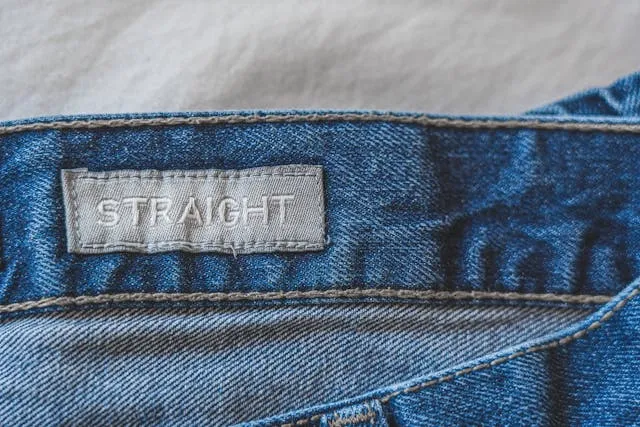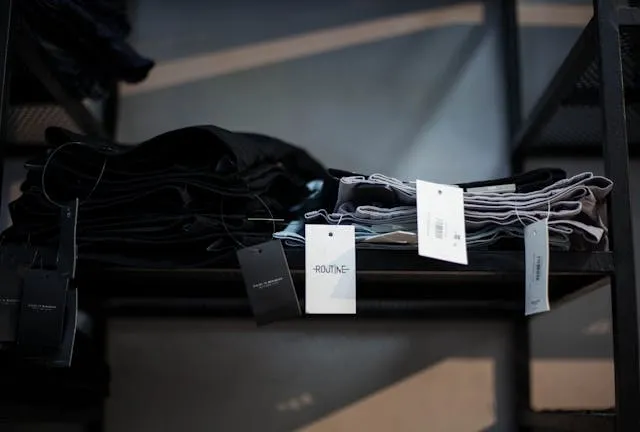How To Attach Tags To Clothes (Step-By-Step Process)
Knowing how to attach tags to clothes is a key step in branding garments, whether you’re a small business, designer, or crafter. By properly securing tags, you add a professional touch to your clothing, ensuring customers can easily find key details like size, care instructions, or brand information.
In this guide, we walk you through the process of attaching tags to clothes. From selecting the right tag type to choosing the best tools and techniques, our straightforward instructions will help ensure your clothing tags are fastened securely to leave a lasting impression on your customers.

Key Takeaways
- You need to select the right tag type for your needs, whether you need a permanent fabric tag or a temporary hang tag for pricing and other needs.
- Tags should be positioned discreetly on casual wear or formal attire so that they don’t impact the appearance of the garment.
- For fabric tags, sewing machines or hand-stitching provide a secure attachment. For hang tags, a tagging gun or safety pin can work without damaging delicate areas.
- We supply high-quality custom clothing patches that can display important information or personalize your garments with versatile styles and attachment methods.
Table of contents
How To Attach Tags To Clothes
Whether it’s custom name patches for jackets or anything else, attaching tags to clothing is a simple process. But it takes attention to details to maintain garment quality, so here’s a step-by-step guide:
- Select the tag type: Common choices include sewn-in fabric tags or hang tags, depending on preferences. Fabric tags are the permanent option, while hang tags can include pricing or product information.
- Positioning: On casual wear like t-shirts or jeans, tags are usually placed inside the neckline or waistband. For formal attire, like suits or dresses, tags are often discreetly positioned inside the lining. Delicate fabrics should have tags placed in less noticeable areas like along the seams.
- Sewing fabric tags: You could use a sewing machine or hang-stitch the tag onto a sturdy seam. Aim for a secure attachment without damaging the fabric.
- Attaching hang tags: Use a tagging gun or safety pin to attach hang tags. Avoid sensitive areas like collars or cuffs where visibility might affect the garment’s appearance.
This way, you ensure the tags are secure and unobtrusive.

Choosing The Right Tools For Attaching Tags
Choosing the right tools for attaching tags is essential to maintain garment quality and keep the tags securely fastened. Here are the main tools and their uses:
- Tagging guns: These are ideal for hanging tags, piercing through the fabric and securing tags with a plastic fastener. They are best used with sturdy fabrics like denim or cotton, but use them with caution.
- Safety pins: Versatile and gentle on fabrics, these are excellent for hanging tags on delicate or formal attire. The pins should be placed in inconspicuous areas to prevent damage.
- Thread and needle: If you are using fabric tags, sewing is a durable option. Use a strong, matching thread to hand-stitch the tag into a seam or hem. This method works well for casual and formal garments, but careful handling is important to avoid fabric snags.
Whether you have fabric tags, paper ones, or heavy-duty polyurethane leather luggage tags, choose the right tools and test on a small, hidden area first to ensure your chosen method is compatible.
Best Practices For Attaching Tags To Delicate Fabrics
Attaching tags to delicate fabrics like silk, lace, or satin requires extra care. Silk has limited durability, so you need to follow best tag attachment practices to prevent damage:
- Choose soft materials: Use gentle, non-abrasive materials for tags and attachments. Opt for fabric tags or those made from lightweight, smooth materials to avoid scratching or leaving marks.
- Hand stitching: Delicate fabrics require you to hand-stitch tags with a fine, matching thread. Sew tags into a seam or hem where they are less likely to cause irritation or impact the garment’s appearance.
- Avoid tagging guns: Tagging guns are a threat to delicate fabrics as they can create holes or cause snags. Opt for safety pins or sew tags by hand instead.
- Careful handling: As you attach tags, be gentle and avoid pulling or stretching the fabric. Prepare a soft surface and avoid placing excessive pressure on the garment.
- Test first: Test your attachment method before applying it. If a patch is iron-on, you will need to take extra care to avoid heat damage.
By following these practices, you can attach your tags without harming the delicate fabrics in any way.
How Are Tags Attached To Clothes In Bulk Manufacturing?
In bulk manufacturing, tags are usually attached to clothes using specialized machinery that offers speed and efficiency. The most common method involves tagging guns, which apply plastic fasteners to quickly secure tags to garments. These tags punch a small pin through the tag and fabric to create a secure attachment with no manual labor.
For higher-volume production, an automated tagging system may be employed. These systems handle multiple garments at once, with conveyor belts to move clothes through the tagging stations. Automated machines can attach tags with a variety of methods, including:
- Heat sealing
- Ultrasonic welding
In some cases, machines may simply apply custom square stickers that convey the necessary information about the garment.
Manual tagging can be labor-intensive and time-consuming. These automated methods take that out of the equation, delivering consistency and reducing the risk of human error. By using machinery, the process is streamlined and manufacturers can meet high production demands efficiently.

Want to make a statement with your team's apparel?
Enhance your uniforms with our custom patches!
Order now and create unique uniforms with our high-quality, personalized patches.
What Are The Benefits Of Attaching Tags To Clothes?
There are several benefits to attaching tags to clothes, primarily that they enhance brand recognition, display product information, and provide consumer convenience. Tags can contain essential details such as:
- Care instructions
- Size
- Pricing
- Branding
These help customers make informed purchasing decisions whilst promoting the maker’s logo and maintaining a cohesive visual identity. It also serves as a visual aid for the owner of the clothing, helping them maintain their garments to maximize their longevity and appeal.
Tags can also help with inventory management and quality control. They serve as a tracking tool, helping businesses streamline checkout processes and facilitate returns or exchanges with clear product information.
Consider incorporating our custom embroidered name patches into your tags to further elevate your brand’s visibility and appeal. Design with us to enhance the aesthetic of your tags and add unique, personalized touches to your garments. By combining functional tagging with stylish patches, you can create a distinctive look that sets your clothing apart from the crowd, making your brand resonate with customers.
What Are Some Fastening Methods For Tags
When attaching tags to clothes, there are a few fastening methods, each of which has pros and cons for different situations.
- Plastic fasteners: These are commonly used in retail as they are quick to apply with a tagging gun on casual wear and mass-produced items. But they often create plastic waste, which we should try to limit since 1-2 million tonnes of plastic enters the oceans annually.
- Thread: Threading tags is a traditional technique that delivers a secure attachment that doesn’t damage most fabrics. It can be used on casual and formal wear, but may not be practical for high-volume production.
- Adhesive labels: These are simple to apply but may not offer the durability to withstand multiple washes. You can use a heat press for iron-on tags for a more secure attachment, but they may be better for temporary applications.
- Stitching: This offers the most secure attachment, suitable for high-end or delicate garments. However, stitching is labor-intensive, and human error could damage the garment.
Stand out from the crowd with our unique designs
Customize your style with our patches!
Order now and make a statement
make your custom patchesHow To Attach Price Tags To Clothes Efficiently?
Attaching price tags efficiently is vital for retail operations. There are several methods that work well for this:
- Tagging guns: The use of a tagging gun is fast and efficient when you need high-volume tagging. You insert the tag into the gun, position it through a small hole or loop in the garment, and pull the trigger. This is a great solution for durable fabrics and casual wear, but the tag should be placed in a visible yet unobtrusive spot to avoid interfering with key features of the garment.
- String: If you prefer a manual approach, you can thread string through the tag and tie it securely to the garment. This is a versatile method that works well for delicate fabrics. You must avoid tying too tightly to prevent distortion and be sure to place it where the garment’s design and functionality are not obstructed.
- Adhesive labels: These are good for swift application and are removable, so they are best suited to temporary tags or lightweight garments. Make sure the label is placed on a flat surface and steer clear of critical areas like necklines or cuffs.
What Are No-Sew Methods For Attaching Name Tags To Clothes?
You will find a number of no-sew methods for attaching name tags to different clothing types:
- Iron-on labels: These are applied using a heat press or an iron. Place the tag on the fabric, cover it with a thin cloth, and press with a hot iron for the recommended time. These are quite durable and work well for a wide range of fabrics, though you should be extra careful with heat-sensitive materials.
- Adhesive tags: These have a strong adhesive backing that sticks directly onto the garment. They are quick to apply and can usually be removed easily, making them ideal for temporary attachments. Alternatively, you could glue patches to fabric for a more permanent solution - just be mindful of the fabric involved.
- Snap buttons: This no-sew option allows for easy attachment and removal of name tags. They are secure, durable, and suitable for heavy fabrics or uniforms. Ensure the snaps are aligned properly and fasten them securely for a durable attachment.
Choose your solution based on your fabric type and intended use, focusing on whether you need a permanent or temporary attachment.
How Do You Reattach Tags That Have Been Detached?
Tags may come off eventually - for instance, how long iron-on patches stay on depends on how you maintain them. If a tag becomes detached, reattaching it requires careful handling to achieve a secure finish. Here are some methods:
- Tagging guns: If a tag was originally attached with a tagging gun, you should be able to use the same method to reattach it. Simply align the tag with the fabric and insert a new fastener with the gun for a secure, professional look.
- Thread or needle: If the tag was sewn on, reattach it by hand with a needle and thread. Make sure you color match and sew through the tag and fabric securely.
- Adhesive: With adhesive tags, clean the area where the tag will be attached to ensure it is free from residue. Apply a new adhesive tag or use high-quality fabric glue for a secure hold.
- Snap buttons: If the tag was attached with snap buttons, replace the missing snap and make sure it has good alignment with existing ones.

How Do You Apply Iron-On Tags To Clothing?
Iron-on tags are best suited to cotton, polyester, and blends, so consider alternatives for silk, lace, and other delicate fabrics. If you order our custom iron-on patches or have iron-on tags for your garments, here are some steps to apply them:
- Preparation: Pre-wash the garment to remove any fabric softeners that might interfere with adhesion. Iron the garment to remove wrinkles since smooth surfaces ensure better contact.
- Positioning: Make sure the iron-on tag is in the desired location, perfectly aligned before you apply heat as it may be difficult to reposition once in place.
- Heat application: Set your iron to the recommended temperature for your fabric type. Place a thin cloth over the tag to shield against direct heat, then press the iron firmly over the tag for the recommended time.
- Cooling: Allow the garment to cool completely before you handle it to ensure the tag adheres properly.
- Care: Always wash the garment inside out in cool water to ensure the tag lasts.
By following these steps, you can keep your iron-on tags in place and maintain a professional look.
Add a personal touch with our custom patches
Express yourself with our wide range of designs
Order now and make it yours.
Frequently Asked Questions About How To Attach Tags To Clothes
How Do You Attach Tags To Fabric?
There are various methods for attaching tags to clothes. Common ones include using tagging guns, safety pins, needle and thread, adhesive tags, or iron-on ones, so you need to choose what is best for you.
What Is Used To Put Tags On Clothes?
This depends on various factors like the clothing type, the fabric, and the purpose of the tag. Real environments often use tagging guns or string, but adhesive and heat-application tags are common choices for garments as well.